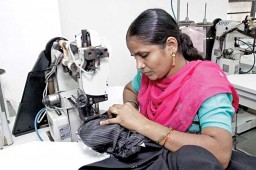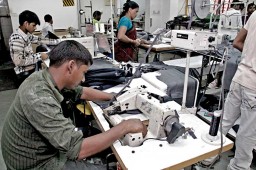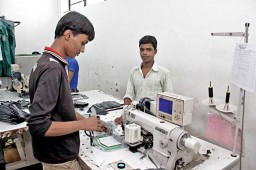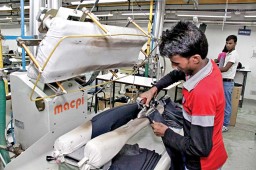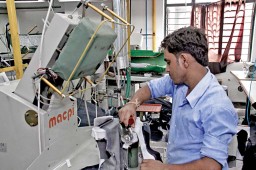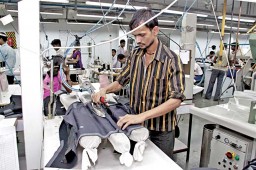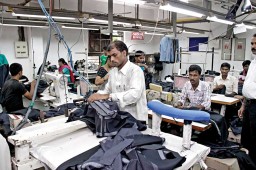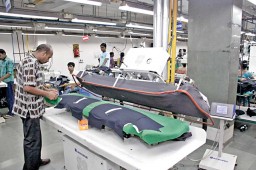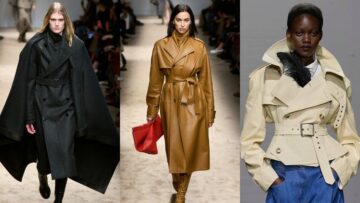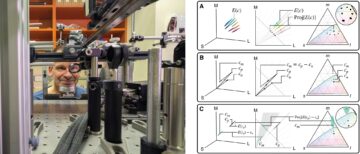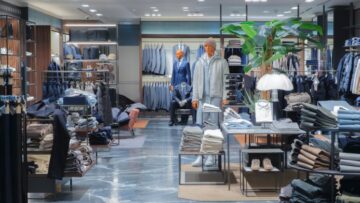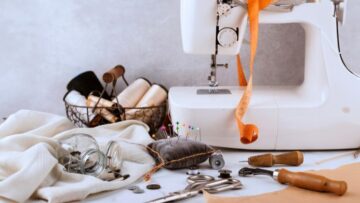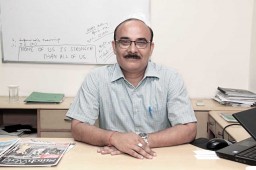
Among the seven well-recognized suit manufacturers in India is the Gurgaon-based Blackberrys, owned by Mohan Clothing Company Pvt. Ltd. Started by the Mohan brothers Nitin and Nikhil Mohan, both alumnus of National Institute of Fashion Technology (NIFT), New Delhi. The company standing tall with a turnover of Rs. 800 crore through its domestic retail in just last two decades, has an even greater and phenomenal manufacturing setup of four units in the Udyog Vihar region, producing 3,60,000 jackets and 14,00,000 trousers annually. Sanjay Anand, Head of Manufacturing, Blackberrys and Niamat Ulla, Factory Manager, Krishna Labels, a unit of Blackberrys spoke to Team StitchWorld, highlighting the consistent focus of the brand on total customer satisfaction through manufacturing excellence.
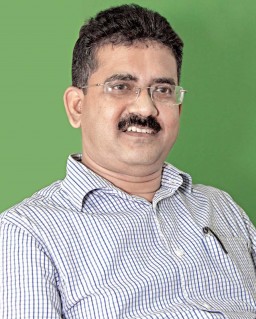
a unit of Blackberrys
Mohan brothers though setup their first manufacturing facility for jackets and blazers in Okhla in the 1990’s under the name Mohan Clothing Company (MCC) with just 25 machines, the company was actually setup in the early 1920s by their grandfather, as a merchant of suiting fabrics based in Chandni Chowk. Unlike many companies who first started manufacturing trousers and then moved to suits, the company first started manufacturing jackets and blazers. Thanks to the apparel manufacturing knowledge of the Mohan brothers, the project was a success and the first trouser line was setup in 1993-94. “Back then our daily production was just 50 pieces of jackets and blazers, made on regular lockstitch sewing machines with under-bed trimmers and without any of the automats like we have now for various operations,” asserted Niamat Ulla.
[bleft]Jackets and blazers are such critical garments, that faults in ‘mm’ at the pattern stage will later blow up to ‘inches’, when the garment has been completely sewn. Hence, people working in suit manufacturing facilities have to be very passionate about the product and particular about the fit, fall and drape of the garment. – Sanjay Anand, Head of Manufacturing, Blackberrys[/bleft]
MCC bought its first set of sleeve setting machines in 1997 and has ever since focussed heavily on automation in the manufacturing operations, whereas finishing machines at the post sewing stage have been present in the company since its inception, it was only later that the need of giving the garments 3D shape was realized. The company presently has at least 40-45 finishing and pressing machines per line, apart from the post-finishing machines. Endorsing the importance of in-line finishing, Sanjay Anand added, “I would say that in-line pressing and finishing operations are slightly more important than the post sewing or end-line operations, as once the jacket is contoured as per the body shape, the inner lining, padding and canvas gets locked. The same can never be achieved with end-line pressing. “The finishing setup of the company endorses the quality of the suits produced by the company, and has been the focus for creating a niche for its products. Most of the machines are from the Italian company MACPI, while a few machines for front part pressing are from Rotondi. “Even after having such advanced machines, being a factory if you don’t maintain the levels of temperature, steam and pressure, a complete garment can be ruined in a matter of seconds,” claimed Sanjay Anand.
Any good suit manufacturing unit should have sewing machines of different types of beds, feeds and stitches. Blackberrys’ manufacturing unit is a testimony to that. While post-bed and cylinder bed makes handling of 3D shape easier during sewing, variable top and bottom feed ensures positive control of fabric plies, be it in applying ease during sleeve attaching or avoiding ply slippage during centre back joining.
Manufacturing Operations
The cutting and spreading operations are manual due to presence of multiple styles in a variety of fabrics. On an average three people are involved in spreading a lay, after which the printed marker from a Gerber plotter and CAD system is placed on the fabric lays. For cutting, end cutters and straight knife cutters from Eastman are used, followed by 100% cut part inspection and bundling of cut parts, which are sent to the part preparation lines. With the bundling being adjacent to the cutting department, a lot of time is saved in terms of transportation and waiting. The company is relatively less automated in the cutting section and no use of pin tables may be attributed to the predominant use of solid colour fabrics. The company is in talks with Lectra for installing an automatic cutting system. Another important function is fusing in suit manufacturing and the company uses machines from Reliant for the same.
The bundles of cut parts received from the part preparation lines are collated at a central location and then distributed to the individual feeding tables of the three final assembly lines. Due to the increased bulk of the product, it is difficult to handle bundles of the same. Hence each operator only works on a single suit at a time. “We have installed a lot of form finishers in the final assembly lines for giving the 3D shaping to the garment, which if bundled would be lost,” shared Niamat Ulla. Each suit is placed on a side table running parallel to the sewing line, on which the operators put the jacket and slide it to the preceding machine. In the assembly line section, the areas of collar attaching, shoulder pad attaching, sleeve attaching and front-back panel attaching via shoulder and side seam are well-defined. Among these are the distinguishable areas for checking fall, checking quality, bundle collection and for special operations like blind stitching and pick stitching.
There are 6-part preparation lines, 2 each for the front including the collar and lapel, back and the sleeves. The production of suits is driven by automation and Mohan Clothing has specialized sewing machines in assembly section for sleeve setting, pick stitching and blind stitching. Automation in sewing is also present in the part preparation lines, in terms of auto-jig sewing machines for making the pocket flaps, eyelet buttonholing machines, buttonhole imitation machines, and pocket welting machines.The company has installed two MJ-3400 Autojig machine for run-stitching on collars, flaps, shoulder tabs, cuffs and collar band, fly piece and lapel. The machine has been designed in such a way that cycle time of the operation is minimized by use of microprocessor-controlled stepping motors and pneumatic systems. Another advantage of this machine is that it does not have a feed dog; instead the machine has a sandwich feeding system for good stitch quality in all kinds of fabric.
[bleft]One of the most distinct highlights of the shopfloor is the presence of temporary reinforcement measures taken for keeping the positioning of the multiple layers of lining, padding, canvas and fusing intact during handling and transportation.
The trouser manufacturing setup of 800 sewing machines has an indigenously developed overhead chain hanging system for efficient movement of the trouser panels within the line, with channels laid out parallel to the sewing lines, attached to the ceiling with chains hanging from them.[/bleft]
For welt pocket preparation on the jacket lining, the company uses the Juki APW-895 for sewing straight welt pockets with flaps and single or double welt variations. The machine is equipped with the world’s first computer-controlled sidewise cutting position of the corner knives, which enables easy adjustments of the knives simply by operation panel. With the new direct-drive motor the power consumption while sewing is reduced by 75% and when on stand-by, by 90%. Compared to its previous versions, a straight welt pocket with back tack is sewing 35% faster by this machine, which on the whole can produce 1900-2300 welt pockets without flaps and 1600-1900 welt pockets with flaps.
The company uses blind stitching machine from the famous but now defunct brand Treasure, with a tape metering and feeding device from Racing, for blind stitching of fusible tape on the jacket front part, which are reinforced while pressing for giving the jacket a better shape and drape. The machine deskills the operation to such an extent that any operator can perform the same, as he/she just has to insert the front panel and guide it in forward direction.
For sewing decorative and non-functional buttonholes on jacket sleeves, the S-4000 chainstitch imitation sleeve buttonhole machine from AMF Reece can sew up to 8 imitation buttonholes at specific distances between each buttonhole. The machine clamps can be set to sew imitation buttonholes at an angle of 0 to 6 degree from a sleeve cuff. The optional laser lights mark the position of the sleeve at the beginning of sewing cycle. With a high-speed of 3800 stitches per minutes, the machine produces 2-3 times more than with a conventional buttonhole machine used without cutting knives for doing the same operation.
For attaching sleeve lining in armholes through the shoulder pad, sleeve lining in the lower armhole section and attaching the sleeve head, Blackberrys has installed the Duerkopp Adler 697-15155, equipped with alternating top feed and needle feed for safe feeding of extreme material thicknesses.
With a post-bed for optimum handling of the work piece, the machine is equipped with an automatic switchable fullness device for precise fullness distribution in the upper or lower material plies. The machine can produce 160-180 pairs of sleeve lining and 400-420 pairs of sleeve heads every 8 hours.
Another highlight of the shopfloor is the PFAFF-937 high-speed zigzag seamer with drop feed and variable top feed, for doing operations like joining the under-collar area to the next opening. The feed system of the machine ensures shift-free joining of parts and precise fullness in the under-collar region of the shoulder area. Again due to the feed system, the machine can perform many different operations on light to medium weight materials.
[bleft]The 15 days training program is aimed at multi-skilling the sewing operators. The operators are trained in a minimum of 5 operations of a jacket or a trouser and these 5 operations belong to a common difficulty-based grouping, which implies if an operator is doing an operation of semi-skilled level, then he would know 5 operations of the same type.
It is not only the operations and operators which are divided, the sewing lines are also categorised as Grade A, B and C as per the types of fabrics they can handle, with A being the most difficult for sewing on non-wool jackets and C being the easiest, handling regular poly-wool materials.[/bleft]
One of the distinct aspects of the suits manufactured by Blackberrys is the hand stitching operation done on the inner lining edges for decorative purposes, which greatly enhances the look of the garment. For performing the same, the company utilizes the Hengtai GL-781 series of pick or hand stitching machines. With a high-speed of 500 stitches per minute, the machine has two separate dials for adjusting the stitch length and the stitch density. The thread trimming mechanism allows the machine to handle standard polyester/nylon cone threads.
Unlike many suit manufacturers using sleeve setting machines from Duerkopp Adler, Blackberrys relies on the Japanese pioneer Juki’s DP-2100 sleeve setting machine. Thanks to Juki’s unique right-and-left independent drive system of the top feed belt, right and left feed amounts can be adjusted separately. This prevents the material from slipping out of position, thereby sewing sleeves with a consistent seam allowance. Unlike conventional sleeve setting machine, the introduction of active-tension enables the separate setting of suitable thread tensions for sewing sleeves on a portion-by-portion basis. This prevents an inadequate thread tension at a portion where the shirring amount is large or an excessive thread tension at a portion where the shirring amount is small. In addition, specified tension settings can be stored in the memory on a pattern-by-pattern basis and can be reproduced with ease. The DP-2100 is the world’s first sleeve sewing machine that has adopted the dry-head technology, which does not need oiling. In addition, the machine comes provided with various data inputting features, such as teaching, grading and mirroring for the easy programming of sewing data and for improved operating efficiency.
As already mentioned, the company’s focus on quality is through in-line pressing for giving proper shape to the suits. The company has more than 20 pressing machines and buck press irons mostly from MACPI, for doing operations like collar seam pressing, left and right forepart under-pressing, ironing centre back and side seam which lock the shape of the suit. For combined pressing of right and left front, the MACPI 207.05-6045 is equipped with laser pointers for positioning darts on the front panels. The machine has a linear travelling frame in which the entire table slides forward to facilitate easy access to the leading area and complete visibility for the operator. The slide-out mechanism of the buck-mounted table eliminates obstruction in the loading area during positioning of jackets, bearing no chance of heat radiation to the operator.
Another highlight of the in-line pressing department is the MACPI 555.04-2164 for pressing and fusing shoulder seam joints. The machine is used both automatic and manual modes, in which first the seams are pressed with an iron for making them uniform, then two pieces of double sided fusing are placed on the two ends, which are then fused via the iron manually and reinforced via the downward pressing upper buck.
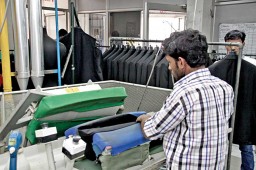
In-line pressing of back portion involves ironing centre back and side seam, for which the company utilizes the MACPI 104.21-0213 sides and centre back seams opening with three narrowbucks; the centre one is straight for centre back seam and two-shaped side bucks for side seam pressing. First the back portion of the jacket is placed over the three bucks, the seam lines are accurately placed over the bucks by use of vacuum and the seam lines are opened manually by an iron. The vacuum can be controlled automatically with diversion of air flow and at max two swivel arms can be fitted with the table.
One of the most distinct highlights of the shopfloor is the presence of temporary reinforcement measures taken for keeping the positioning of the multiple layers of lining, padding, canvas and fusing intact during handling and transportation. Firstly, in the front part preparation lines, temporary reinforcements are done on the armhole curve on the front pattern, where just after the pressing of the panel; the armhole line is stapled via staplers which are undone just before the topstitching operation on the same armhole line, which leaves no marks on the fabric. This special reinforcement through stapling is done for maintaining the position of the different layers of lining and other materials like padding, canvas and fusing, which get displaced while transportation.
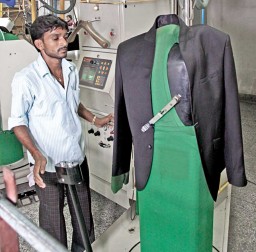
The same type of temporary reinforcement is also done on the placket edge of the front, before sending the same for pressing. The second reinforcement is done on the same armhole region, when the entire suit is ready for sleeve setting in the assembly lines. The unfinished jackets are hung on dress forms and the hand stitching is done by operators on the armhole region, before sending the piece for sleeve setting.
While the part preparation lines do not have many quality checking stations, the same are present in abundance in the assembly lines as a jacket starts taking shape in the assembly lines and additional operators are placed for checking the finishing, pressing, pocket welting shape, fall of the jacket and texture of the lining, besides the rest for checking the sewing quality. Another highlight of the manufacturing setup, in terms of jackets and blazers, is the manufacturing of waistcoats going in the same lines as of jackets without the need of setting up a separate line or section for the same.
The trouser manufacturing setup of 800 sewing machines has an indigenously developed overhead chain hanging system for efficient movement of the trouser panels within the line. The overhead chain transport system is a very basic form of an overhead material handling system, with channels laid out parallel to the sewing lines, attached to the ceiling with chains hanging from them, affixed via sliders for easy movement of pieces hanging on the bottom of the chains.This cost-effective system has totally removed any kind of boxes used for storage of pieces in process, from not only the part preparation and final assembly but also the in-line ironing and pressing area.
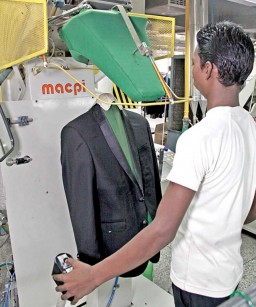
This unit also houses the complete post sewing finishing department of jackets and waistcoats comprising of more than 20 fully automated finishing machines. Most of the machines were a repetition due to their presence in the sewing lines, used just for further reinforcing the shaping of the front, collar and lapel.
However, the machines which highlighted the end-line finishing department were the laser guided machines for shoulder and sleeves, whose finishing and pressing was done manually on buck press ironing machines in the sewing departments. The WIP for the finishing department is stacked everyday for feeding, after which the buttons and button holes are finally sewn on the jackets, along with the waistcoats. Adjacent to the jacket final finishing section, is the same for trousers equipped with double legger, trouser topper, trouser leg ironing table and ironing table for trouser seat seams, with machines again from Macpi and a lesser known Korean company Kumsung.
A standard quality system is followed by the company in its facilities and also in its vendor’s factories. “Jackets and blazers are such critical garments that fault of even a fraction of an ‘mm’ in the patterns will blow up to ‘inches’ on a finished garment,” averred Sanjay Anand. The quality checks starts from the fabric, first the FBT (Fabric Bulk Test) is done comprising of chemical tests for checking the colour fastness, crocking and washing fastness tests are conducted, and non-adherence to the standards leads to rejection of the complete lot, after which 100% fabric is inspected for visual defects, followed by 100% cut part inspection is done by the in-house stationed QAs. Later in the sewing department, an in-line and end line QAs check the garments at 1.5 AQL. “In our central warehouse, we have a general audit system, in which a totally different team carry’s out random inspections, irrespective of the source,” added Sanjay Anand.
Operator Skill Development and Management
Suits as a product requires the highest level of precision and accuracy in the manufacturing stages, which can only be made possible by inculcating discipline, commitment and passion towards the product, in all the people involved in the manufacturing process. Fresh operators go through a 15 days’ training program, which is a must as most of the operators come from nearby factories involved in the manufacturing high-fashion ladies garments, exactly opposite of what a jacket and trouser is like. “We intend on training fresh operators in the sewing operations with the lowest learning curve,” shared Niamat Ulla. The training is not only about learning the respective operations, but rather about getting attuned to the working environment
of Blackberrys.
The training program is aimed at multi-skilling the sewing operators as due to the general mind-set of the labour in the region, the absenteeism and labour turnover is very high and with multi-skilling the dependency of any operations on a single or a few operators is reduced drastically.“The operators are trained in a minimum of 5 operations of a jacket or a trouser and these 5 operations belong to a common difficulty-based grouping, which implies if an operator is doing an operation of semi-skilled level, then he would know 5 operations of the same type,” explained Sanjay Anand. Moreover due to the high-level of automation in the sewing lines most of the sewing operations have been deskilled to a great extent, further making deskilling easier.
The operator’s grade in the skill matrix is dependent on the same categorisation of operations as per their difficulty level and as the learning curve of an operator reduces, they are promoted to do operations of higher difficulty, however only after achieving the respective efficiency standards. “In jackets, we have recorded efficiencies from 40% to 55%, and in the trouser lines operators have touched the mark of 63%,” averred Sanjay Anand.
It is not only the operations and operators which are divided, the sewing lines are also categorised as Grade A, B and C as per the types of fabrics they can handle; with A being the most difficult for sewing on non-wool jackets, and C being the easiest, handling regular poly-wool materials. “Our A grade sewing lines have the highest skill-set in terms of sewing operators, with the ability to do multiple sewing operations and are called floaters,” shared Niamat Ulla. Machine-wise the difference is not too much in all the three types of sewing lines.
For moving up a grade, an operator has to learn at least 5 operations of the higher grade, which further defines their earning potential.“Apart from the basic pay, the operators earn 20% to 25% additional income in form of incentives,” added Sanjay Anand. The incentives are not only dependent on the performance but also the quality delivered, overall behaviour and attendance.

